BUICK PARK AVENUE 1993 Manual Online
Manufacturer: BUICK, Model Year: 1993, Model line: PARK AVENUE, Model: BUICK PARK AVENUE 1993Pages: 340, PDF Size: 18.17 MB
Page 81 of 340
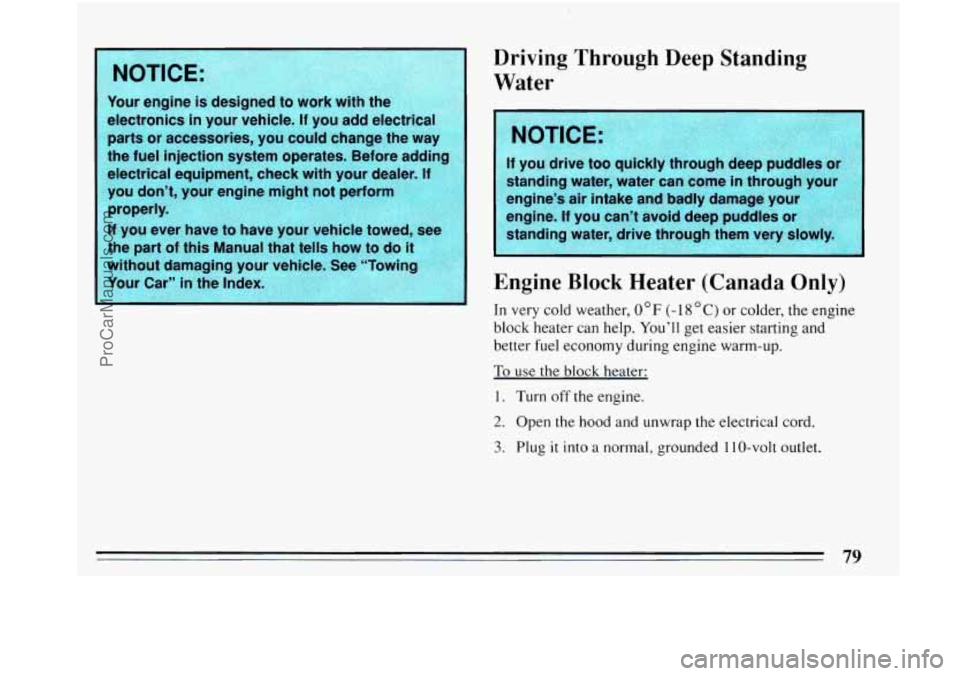
Driving Through Deep Standing
Water
standing water, water can come in through your
engine's air intake and badly damage your
engine.
If you can't avoid deep puddles or
standing water, drive through them very
s
Engine Block Heater (Canada Only)
In very cold weather, 0 " F (- 18 "C) or colder, the engine
block heater can help. You'll get easier starting and
better fuel economy during engine warm-up.
To use the block heater:
1. Turn off the engine.
2. Open the hood and unwrap the electrical cord.
3. Plug it into a normal, grounded 110-volt outlet.
ProCarManuals.com
Page 82 of 340
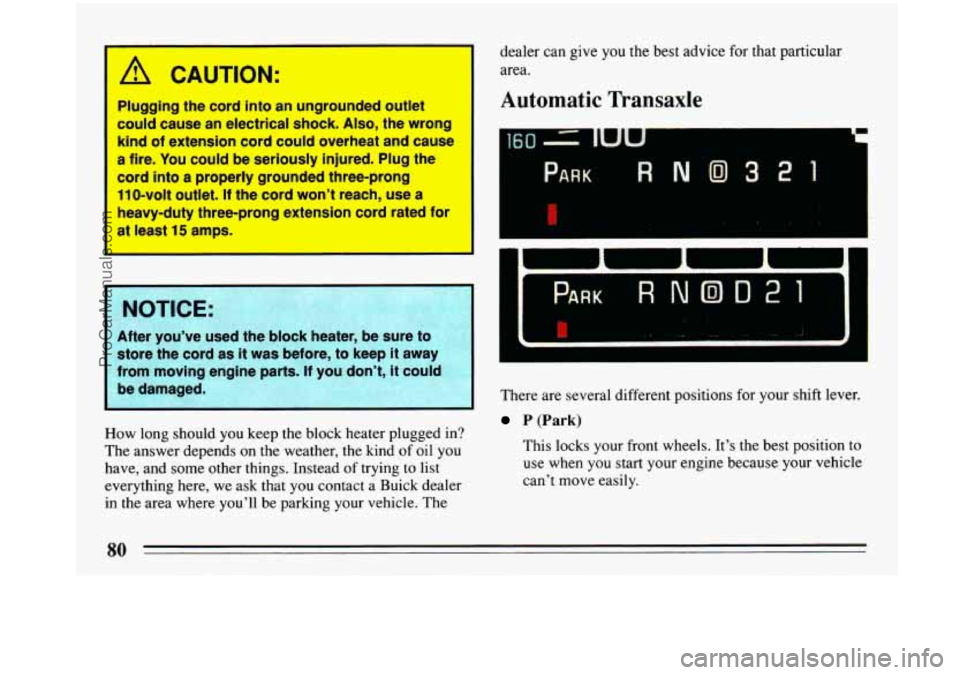
A CAUTION:
I
Plugging the cord into an ungrounded outlet
could cause an electrical shock.
Also, the wrong
kind of extension cord could overheat and cause
a fire. You could be seriously injured. Plug the
cord into a properly grounded three-prong
110-volt outlet. If the cord won’t reach, use
a
heavy-duty three-prong extension cord rated for
at least
15 amps.
I
I NOTICE:
After you’ve used the block heater, be sure to
store the cord as
it was before, to keep it away
from moving engine parts. If you
don’t, it could
be damaged.
1
I
How long should you keep the block heater plugged in?
The answer depends on the weather, the kind
of oil you
have, and some other things. Instead
of trying to list
everything here, we ask that
you contact a Buick dealer
in the area where you’ll be parking your vehicle. The dealer
can give you the
best advice for that particular
area.
Automatic Transaxle
160 - IULJ
PARK FINO321
i
b
PARK R N 0 D 2 1
There are several different positions for your shift lever.
P (Park)
This locks your front wheels. It’s the best position to
use when you start your engine because your vehicle
can’t move easily.
I
80
ProCarManuals.com
Page 83 of 340
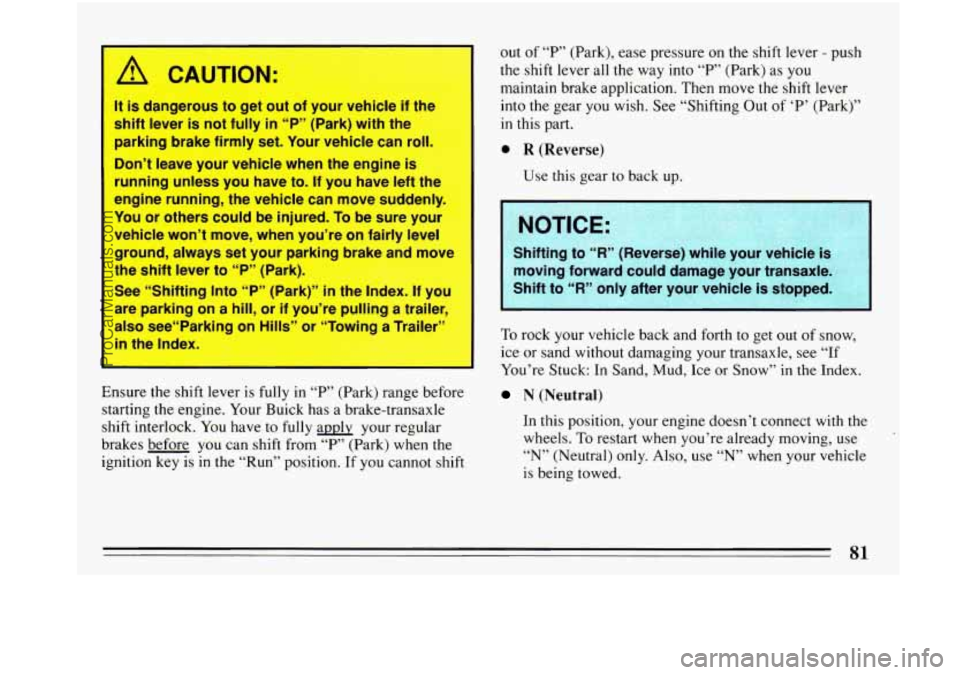
I A CAUTION:
It is dangerous to get out of your vehicle if the
shift lever is not fully
in “P” (Park) with the
parking brake firmly set. Your vehicle can roll.
Don’t leave your vehicle when the engine is
running unless you have to.
If you have left the
engine running, the vehicle can move suddenly.
You or others could be injured. To be sure your
vehicle won’t move, when you’re on fairly level
ground, always set your parking brake and move
the shift lever to “P” (Park).
See “Shifting Into “P” (Park)”
in the Index. If you
are parking on a
hill, or if you’re pulling a trailer
also see“Parking on Hills” or “Towing a Trailer’
in the Index.
Ensure the shift lever is fully in “P” (Park) range before
starting the engine. Your Buick has a brake-transaxle
shift interlock. You have
to fully apply your regular
brakes before you can shift from “P” (Park) when the
ignition key is in the “Run” position. If you cannot shift out
of
“P” (Park), ease pressure on the shift lever - push
the shift lever all the way into
“P” (Park) as you
maintain brake application. Then move the shift lever
into the gear you wish. See “Shifting Out
of ‘P’ (Park)”
in this part.
0 R (Reverse)
Use this gear to back up.
Shifting to ‘W’ (Reverse) while your vehicle is
moving forward could damage your transaxle.
Shift to
“R” only after your vehicle is stoppc
To rock your vehicle back and forth to get out of snow,
ice or sand without damaging your transaxle, see
“If
You’re Stuck: In Sand, Mud, Ice or Snow” in the Index.
N (Neutral)
In this position, your engine doesn’t connect with the
wheels.
To restart when you’re already moving, use
“N” (Neutral) only. Also, use “N” when your vehicle
is being towed.
ProCarManuals.com
Page 84 of 340

I
A CAUTION:
Shifting out of “PYy (Park) or “N” (Neutral) while
’ your engine is “racing” (running at high speed)
is dangerous. Unless your foot
is firmly on the
brake pedal, your vehicle could move very
rapidly. You could lose control and hit people or
objects. Don’t shift out of “P” (Park) or “N”
I (Neutral) while your engine is racing.
Damage to your tia,lsaxI
Going about 35 mph (56 km/h) or more, push the
accelerator all the way down.
You’ll shift down
to the next gear and have more
power.
0 D or 3 (Third Gear)
This is like @, but you never go into Overdrive.
Here are some times you might choose
“D or 3”
instead of @:
- When driving on hilly, winding roads
- When towing a trailer, so there is less shifting
between gears
- When going down a steep hill
0 2 (Second Gear)
This position gives you more power but lower fuel
economy. You can use
“2” on hills. It can help
control your speed as
you go down steep mountain
roads, but then you would also want to use your
brakes off and on. 0 @ Automatic Overdrive
This position is for normal driving. If you need more
power for passing, and you’re:
- Going less than about 35 mph (56 km/h), push
your accelerator pedal about halfway down.
82
ProCarManuals.com
Page 85 of 340
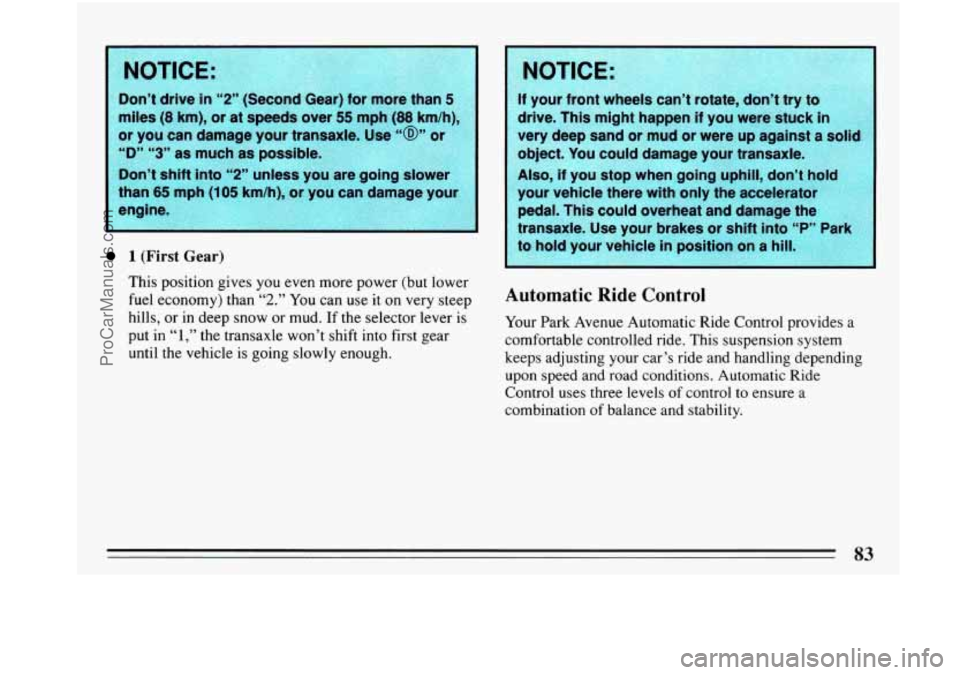
NOTICE: , * _. s*, ?x-&.
Don’t drive in “2” (Second Gear) for more than 5
miles (8 km), or at speeds over 55 mph (88 - km/h),
or you can damage your transaxle. Use
“@” 01
“D” “3” as much as possible
Don’t shift
into “2” unless you are going slower
than
65 mph (105 km/h), or you can damage your
1 (First Gear)
This position gives you even more power (but lower
fuel economy) than “2.” You can use it on very steep
hills, or in deep snow
or mud. If the selector lever is
put in
“1,” the transaxle won’t shift into first gear
until the vehicle is going slowly enough.
NOTICE:
If your front wheels can’t rotate, don’t try to
drive. This might happen if you were stuck in
very deep sand or mud or were up against a solid
object.
You could damage your transaxle.
Also, if you stop when going uphill, don’t hoW
your vehicle there with only the accelerator
pedal. This could overheat and damage
th
transaxle. Use your brakes or shift intc ‘‘D
to hold your vehicle in position on a
Automatic Ride Control
Your Park Avenue Automatic Ride Control provides a
comfortable controlled ride. This suspension system
keeps adjusting your car’s ride and handling depending
upon speed and road conditions. Automatic Ride
Control uses three levels
of control to ensure a
combination
of balance and stability.
83
ProCarManuals.com
Page 86 of 340
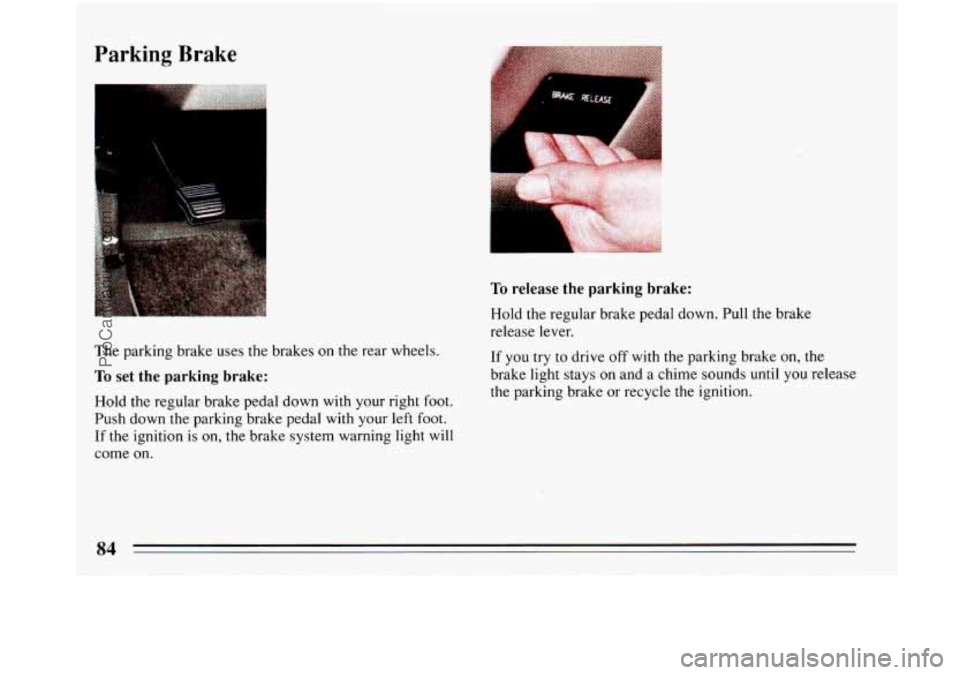
Parking Brake
The parking brake uses the brakes on the rear wheels.
To set the parking brake:
Hold the regular brake pedal down with your right foot.
Push down the parking brake pedal with your
left foot.
If the ignition
is on, the brake system warning light will
come on.
To release the parking brake:
Hold the regular brake pedal down. Pull the brake
release lever.
If you try to drive off with the parking braKe on, the
brake light stays on and a chime sounds until
you release
the parking brake or recycle the ignition.
ProCarManuals.com
Page 87 of 340
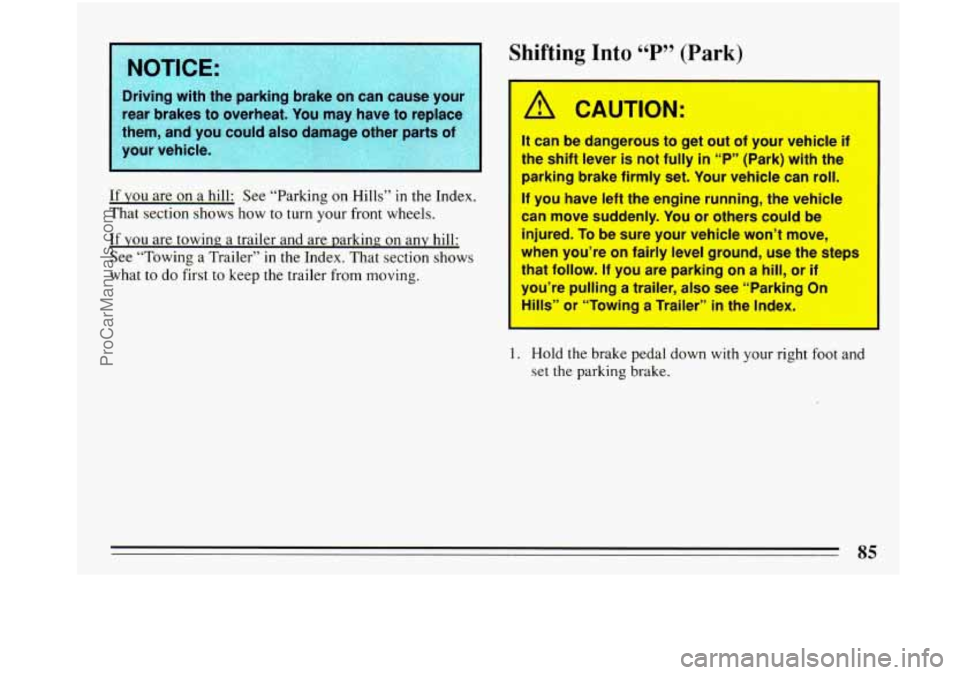
Driving with the parking brake on can cause youkz.,--.I
rear brakes to overheat.
You may have to replace-
them, and you could also damage other parts of
If YOU are on a hill: See “Parking on Hills” in the Index.
That section shows how to turn your front wheels.
If you are towing a trailer and are parking on any hill:
See “Towing a Trailer”
in the Index. That section shows
what
to do first to keep the trailer from moving.
Shifting Into “P” (Park)
A CAUTION:
It can be dangerous to get out of your vehicle if
the shift lever is not fully in “P” (Park) with the
parking brake firmly set. Your vehicle can roll.
If you have left the engine running, the vehicle
can move suddenly. You or others could be
injured. To be sure your vehicle won’t move,
when you’re on fairly level ground, use the steps
that follow.
If you are parking on a hill, or if
you’re pulling a trailer, also see “Parking On
H”‘ ;” or “Towing a Trailer” in the Index.
1. Hold the brake pedal down with your right foot and
set
the parking brake.
ProCarManuals.com
Page 88 of 340
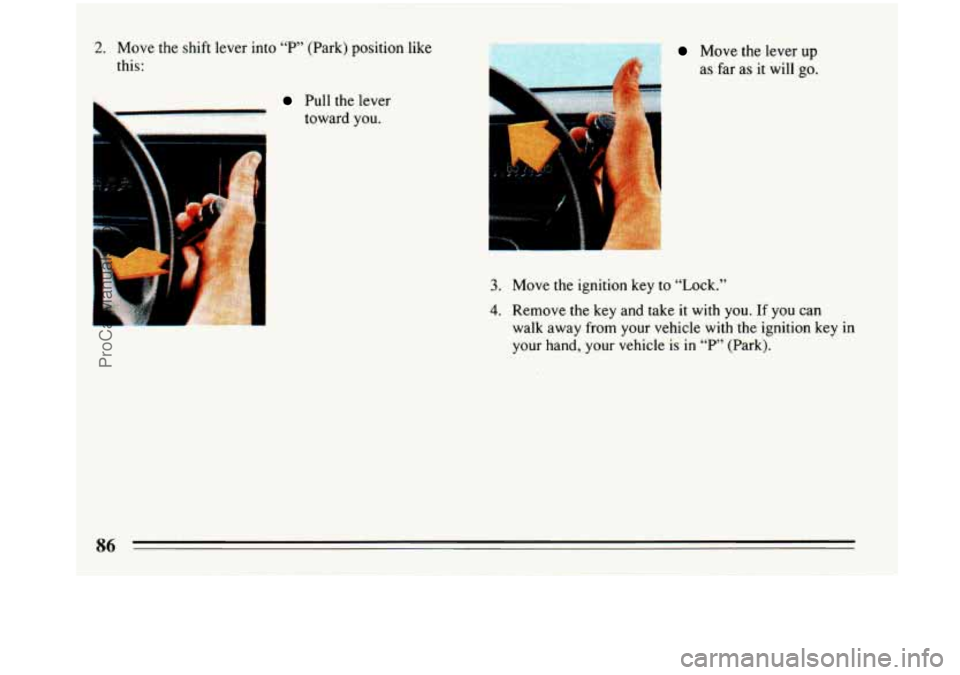
2. Move the shift lever into “P” (Park) position like
this:
Pull the lever
toward
you. L. P.
.= Move the lever up
as
far as it will go.
7.:- .* I .
P
3. Move the ignition key to “Lock.”
4. Remove the key and take it with you. If you can
walk away from your vehicle
with the ignition key in
your hand, your vehicle is in “P” (Park).
ProCarManuals.com
Page 89 of 340
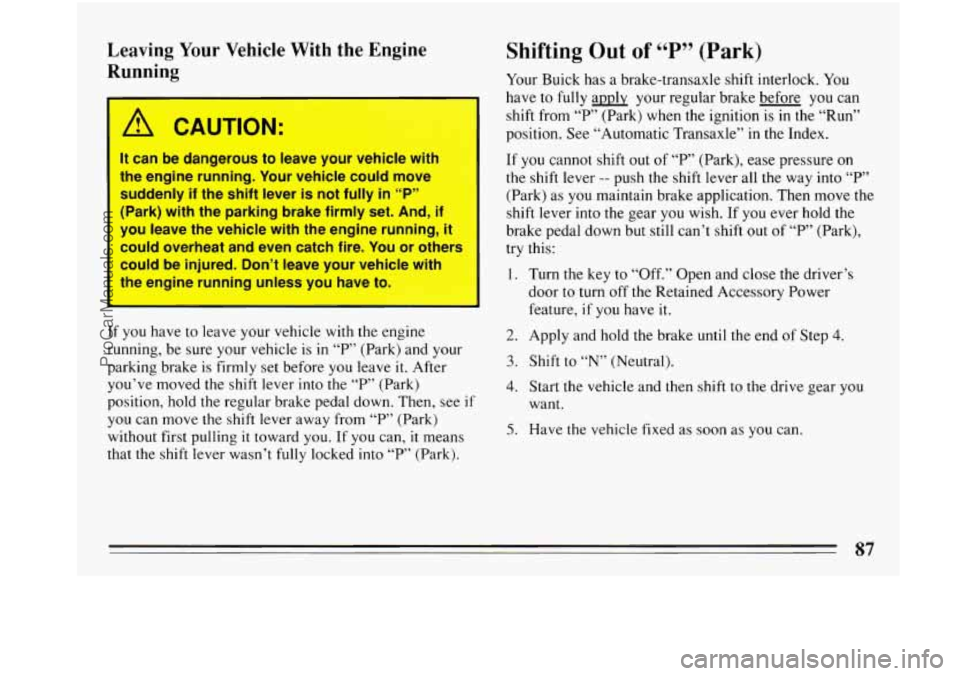
Leaving Your Vehicle With the Engine
Running
I
A CAUTION:
It can be dangerous to leave your vehicle with
the engine running. Your vehicle could move
suddenly
if the shift lever is not fully in “P”
(Park) with the parking brake firmly set. And, if
you leave the vehicle with the engine running,
it
could overheat and even catch fire. You or other3
could be injured. Don’t leave your vehicle with
the engine running unless you have to.
If you have to leave your vehicle with the engine
running, be sure your vehicle is in “P” (Park) and your
parking brake is firmly
set before you leave it. After
you’ve moved the shift lever
into the “P” (Park)
position, hold the regular brake pedal down. Then, see if
you can move the shift lever away from “P” (Park)
without first pulling it toward you. If you can, it means
that the shift lever wasn’t fully locked into “P” (Park).
Shifting Out of 46 P $9 (Park)
Your Buick has a brake-transaxle shift interlock. You
have
to fully apply your regular brake before you can
shift from “P” (Park) when the ignition is in the “Run”
position. See “Automatic Transaxle” in the Index.
If you cannot shift out of
“P” (Park), ease pressure on
the shift lever
-- push the shift lever all the way into “P’
(Park) as you maintain brake application. Then move the
shift lever into the gear
you wish. If you ever hold the
brake pedal down but still can’t shift out of “P” (Park),
try this:
I. Turn the key to “Off.” Open and close the driver’s
door to turn off the Retained Accessory Power
feature,
if you have it.
2. Apply and hold the brake until the end of Step 4.
3. Shift to “N” (Neutral).
4. Start the vehicle and then shift to the drive gear you
want.
5. Have the vehicle fixed as soon as you can.
87
ProCarManuals.com
Page 90 of 340
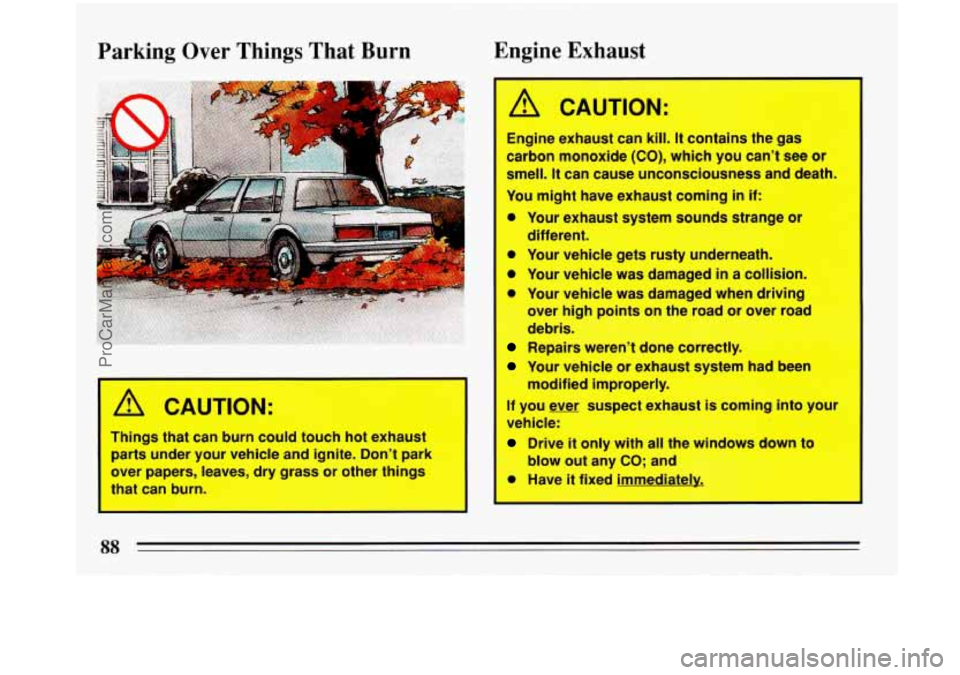
Parking Over Things That Burn Engine Exhaust
A CAUTION:
I Things that
can burn could touch hot exhaust
parts under your vehicle and ignite. Don't park
over papers, leaves, dry grass or other things
that can burn.
A CAUTION:
Engine exhaust can kill. It contains the gas
carbon monoxide
(CO), which you can't see or
smell. It can cause unconsciousness and death.
You might have exhaust coming
in if:
0 Your exhaust system sounds strange or
0 Your vehicle gets rusty underneath.
0 Your vehicle was damaged in a collision.
0 Your vehicle was damaged when driving
over high points on the road or over road
debris.
different.
Repairs weren't done
correctly.
Your vehicle or exhaust system had been
If you ever suspect exhaust is coming into your
vehicle:
Drive it only with all the windows down to
blow out any
CO; and
0 Have it fixed immediately.
modified
improperly.
ProCarManuals.com